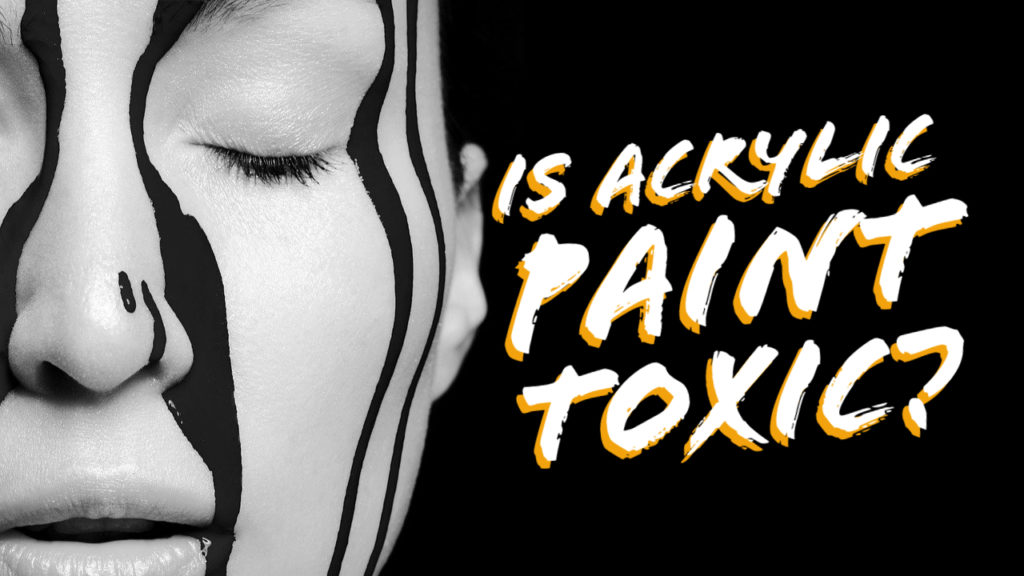Do you love to paint? Coloring makes things bright and bold. There are different types of color such as watercolor, acrylic, oil painting, etc. But acrylic paints are considered one of the safest paints for art and craft due to having water-based solvent.
So, is acrylic paint toxic? Well, in most cases acrylic paints are not toxic and very safe to use, but in some special cases it can also contain harmful chemicals which are hazardous for health.
Do you know how you can prevent the health risk when using acrylic color? In the below article, we will discuss all of your common questions about the toxicity of acrylic paint.

Is acrylic paint toxic? My Raw Thoughts
If the acrylic color is used for art or creative painting, it will not harm. Due to its water-based character, the paint doesn’t need any toxic cleaning chemicals. However, there are a few variants of the acrylic paint having additives such as colors and pigments. Such paints are toxic and hazardous for our health.
In short, toxicity doesn’t matter when you paint on paper but be careful while using it with bare finger, especially for the paints having additives. It contains harmful components like lead, cobalt, chromium, manganese, and cadmium.
So, plan to use it in a proper way which includes spraying in a well-ventilated space. You can ask the manufacturer to know about the right way to spray it. It will help you to avoid breathing these chemical particles released into the air.
However, swallowing a large amount of acrylic paint leads to dangerous health risks.
Toxicity of Acrylic Paint
Acrylic paint is not toxic when it is used for painting purposes. The acrylic color contains some toxic chemicals such as cadmium, cobalt, manganese, chromium, and lead. These chemical particles get mixed into the air when the acrylic paint is used for airbrushing and sanding. To avoid its toxicity, you can use it for acrylic painting purposes.
The acrylic paint is safe to use if it is used properly. For being water-based, the paint is easy to clean with soap and water and doesn’t need any toxic chemicals.
Points to Consider When Using Acrylic Paints
Know what your paints are made of:
The acrylic paint contains plasticizers, silicon oils, defoamers, stabilizers, or metal soaps with acrylic polymer emulsions and an acrylic polymer binder.
In that case, when using acrylic, it starts to spread ammonia, water and propylene glycerol which makes it unsafe for the environment.
Some acrylic paint may also contain some heavy metals which are hazardous to health. So, it is always a good idea to check the ingredients before you buy them.
Be aware of these pigments:
You can get plenty of information about the product’s safety and risky ways to use them from its label. You can also search for the manufacturer websites to get the right info about it. However, you should always think about all of your paints as harmful.
Sometimes it may form irritation on the skin, eyes and can bring unexpected nausea, vomiting, and headache like short term potential issues.
But long time exposure can cause some serious long term potential health issues like nervous damage, organ damage, Eczema, dizziness and fatigue as it contain many carcinogenic organic compound. So handle with care only.
Keep Your Workplace Safe:
When the acrylic paint starts to dry, it releases harmful chemicals into the air. So keeping the area well ventilated cut out the risk of ingesting toxic chemicals from the area. For a short time project, you can keep a window open and for a big project, ventilation is a must.

Apart from that, you should not bring any food or drink in the area exposed to acrylic paint. Otherwise, avoid taking food with your hand. If possible, wash your hands before touching food.
Disposing of Acrylic Paint:
You are likely to generate a lot of waste during painting. The disposal should be in the right way as some of them can be suspended in water.
‘Non-toxic’ statement on the label indicates that it’s safe for humans but not for the environment as well. You need to clean your paintbrushes carefully as these small particles of acrylic paint can mix to the waterline through basin sink.
Also don’t throw the pigmented acrylic in water as it may cause problems when it flows into the water system. Rather keep it in a container that can be sealed off. After that, you can inform the municipality to collect the color from you in a large amount so that they can dispose of it correctly. In fact, you should also know how to get rid of acrylic paint from clothes.
Use protective gear:
Proper handling of acrylic paint must be written on its label. Otherwise, you can take your precautions such as:
- Use Nitrile-coated gloves and goggles when handling it.
- Don’t forget to wear a good filter mask. When using acrylic paint, present at least one person near to you. So that the person can save you from any type of danger or in case you get a severe breathing problem due to inhale of toxic material in the paint.
- If your body comes into contact with this chemical, then don’t forget to flush it with plenty of freshwaters.
Is Acrylic Paint Safe for Kids?

There are alternative ways of arts and crafts to make your baby’s childhood best. In that case, painting can be the easy way. But how safe is acrylic paint for your kids? Let’s explore it in detail.
Non-toxic labels on paint don’t ensure safety. Toxicity depends on the reaction with a certain element on the natural organism, cells or tissue.
However, being non-toxic the acrylic paint is safe for short time wear. But don’t let the baby skin absorb it. While coloring with this paint, there will be a little sludge over the skin and you will not have any reaction. But remember, not everyone’s skin reacts the same way.
Let’s get some quick tips to keep your child safe from acrylic paint.
- Take a small amount of paint and apply it to the skin. Let’s observe if it comes out with any adverse reaction or not.
- Acrylic paint contains formaldehyde, so use it on a surface where there is enough air circulation.
- In case of skin contraction, don’t take your nose close to your mouth to avoid ingestion or inhaling.
- Check the ingredients. If there is any toxic chemical in a large amount, then you should surely skip buying it.
Is Acrylic Paint Toxic For Baby Handprints?
Acrylic paint can be used for baby handprints. Every parent wants to cherish their baby’s handprints forever. These handprints are done on paper or sculpted with clay. But before you go for paint, make sure the paint is non-toxic and water-based.
In this case, tempera paint or Crayola paint can be a great option. Ink is always a better option as it has less risk.
How Do You Get Acrylic Paint off Baby Skin?
You can easily get acrylic paint out from your baby skin as these are water-based. Here is a quick guide to removing it.
- Wet the area where paint is applied.
- Properly clean the area using bar or dish soap.
- Scrub the area mildly.
- Rinse it with water until all paint is removed.
You can also use baby oil or butter, rubbing alcohol, Moisturizer, hand sanitizer, as per your convenient. These products are not only safe for bay skin but also easy to use.
- Take some baby oil or butter on your fingertips and gently massage on the painted area of your baby’s skin. Scarp the area softly with your fingernails to crack it up. Then rinse the area properly with fresh water though you can also use soap in this process if it’s handy.
- In case of petroleum jelly or Vaseline as oil based remover you can continue with the same process as mentioned above. But parents normally uses this because it is pretty safe for child skin.
- Rubbing alcohol and hand sanitizers are pretty much same in nature. In case any paint particle left after using oil based product. You can easily clean it up with rubbing a blotted alcohol sponge. Use soap and water to get rid of the bad odor.
What to do if Acrylic Paint is Ingested?
In case, the acrylic paint is ingested at a small amount, don’t worry. Just relax and drink a cup of water. Just monitor the victim for a few hours if he is raising any allergic reaction or not.
But in case the ingested paint is in decent amount first you should take the help of a poison control. Gargling with mild warm salt water and brushing the teeth properly can also help.

Is Acrylic Paint Toxic to Pets?
The acrylic paint may irritate the skin of your pets. But this is a matter of concern if the pet takes a large amount of it. The toxicity of acrylic paint depends on several factors such as the particles of the paint and the weight of the pet.
Is acrylic paint safe for dogs:
Water-based acrylic paint may irritate their skin as well as the mucus membranes. The acrylic paint toxicity or a large amount of ingestion of it may cause nausea and vomiting for your furry friend. If you suspect your dog with a large amount of acrylic congestion, call your vet doctor immediately.
However, keep in mind that toxic fumes are not safe for dogs. It can be too strong for them. So, you are suggested to keep them out until the odour is diminished.

Is acrylic paint Toxic for cats:
The vet doctors affirm that a small amount of paint is not enough to give your cat any toxicity alarm. In that case, observe them if they are drooling or having any changes in their appetite or if they are acting differently.
FAQs
Get your questions answered here:
Can you body paint with acrylic?
Acrylic paint is not safe for the skin. It contains toxic chemicals that may cause skin irritation. Check the ingredients of it on its label which are not a safe option for body skin.
Can paint smell be harmful?
Paints are safe. Exposure to paint smell may irritate the skin, eyes and throat. Some of the paints contain VOC that can bring short and long term health risks.
Which paint is the safest for a nursery?
Before using any paint for a nursery, make sure it is free from toxic chemicals. Tempera and crayola paint can be a good option for the nursery. Otherwise, ink can be used instead of paint.
How long can paint hold it toxic smell?
Paint fumes sometimes can be seen to cause serious health problem because of several injurious chemical present in these products. Normally it takes about 2-3 days to dry and completely minimize its typical toxic smell.
Also Read: How to Paint on Fabric Permanently
Final Words
Hopefully, I have managed to answer your question i.e. is acrylic paint toxic? We can conclude that the acrylic paint is safe when it is used properly. Follow the instructions of the manufacturer when using acrylic paint. Proper usage, right cleaning and exact disposal can result in your safety and this is also safe for the environment.
Hence the article will show you the right path for using acrylic. Painting is good for mind and health wellness. But don’t let it be bad for your health. Safely enjoy your hobby. Happy painting.



